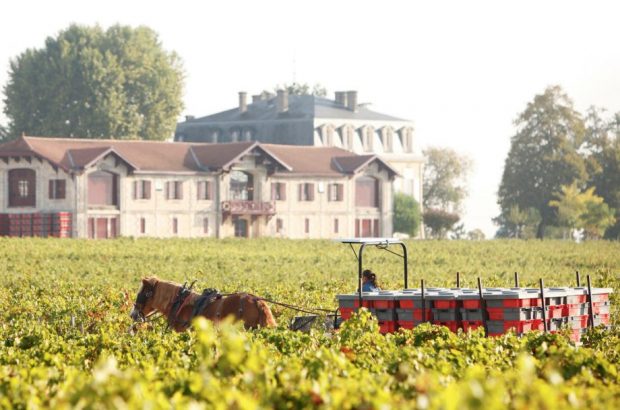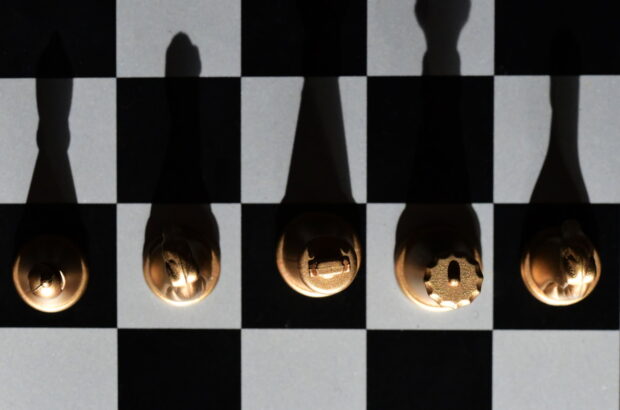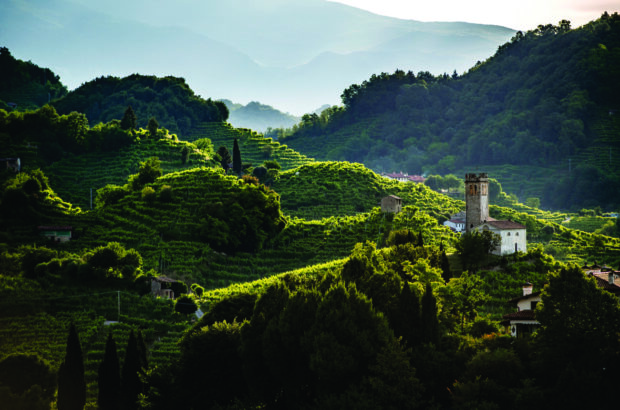While Champagne gets much of the sparkling wine glory, with its established image of prestige, and Prosecco the lion’s share of attention at the more affordable end of the market, there is no French wine category more versatile and complex than its crémant sparkling wines.
Scroll down for tasting notes and scores on the 25 top-scoring crémants
This single designation comprises eight officially classified appellation regions within France, including Crémant de Alsace, de Bordeaux, de Bourgogne, de Loire and de Limoux, each with its own distinct style and unique blend of grapes best-suited to its region.
Indeed a glass of crémant could comprise 100% of varieties including Riesling, Chenin Blanc or Jacquère, a 50/50 blend of Sauvignon Blanc and Muscadelle, or Champagne varieties Chardonnay and Pinot Noir.
Unlike Prosecco, which undergoes fermentation in tank, these traditional-method French sparkling wines are made in the same labour-intensive way as Champagne, with a secondary bottle fermentation and ageing in bottle on lees for a minimum of nine months or longer, to develop body and complexity.
{"content":"PHA+TW9yZSB0aGFuIDgwMCDDqWxhYm9yYXRldXJzIG1ha2UgYWJvdXQgMTEwIG1pbGxpb24gYm90dGxlcyBhbm51YWxseSwgYWNjb3JkaW5nIHRvIHRoZSBmZWRlcmF0aW9uIHJlcHJlc2VudGluZyBjcsOpbWFudCBwcm9kdWNlcnMgYWNyb3NzIEZyYW5jZSwgRk5QRUMuIFdoaWxlIGNyw6ltYW50IHByb2R1Y3Rpb24gdm9sdW1lcyBhcmUgYWJvdXQgb25lIHRoaXJkIG9mIENoYW1wYWduZeKAmXMgdG90YWwsIGFuZCBpdCBtYXkgbGFjayB0aGUgaGlzdG9yaWNhbCBhc3NvY2lhdGlvbnMgb2YgQ2hhbXBhZ25lLCBjcsOpbWFudCBpcyBleHBlcmllbmNpbmcgYSBzdXJnZSBvZiBwb3B1bGFyaXR5IGFuZCBpcyBpbmNyZWFzaW5nbHkgdGhlIGZpenogb2YgY2hvaWNlIGZvciB3aW5lIGxvdmVycyBzZWVraW5nIHRoZSBzd2VldCBzcG90IGJldHdlZW4gcHJpY2UgYW5kIHF1YWxpdHkuPC9wPgo8cD48ZGl2IGNsYXNzPSJhZC1jb250YWluZXIgYWQtY29udGFpbmVyLS1tb2JpbGUiPjxkaXYgaWQ9InBvc3QtaW5saW5lLTIiIGNsYXNzPSJpcGMtYWR2ZXJ0Ij48L2Rpdj48L2Rpdj48L3A+CjxwPuKAmFNpbmNlIE1hcmNoIDIwMjAgYW5kIHRoZSBmaXJzdCBsb2NrZG93biwgd2Ugd2VyZSBpbnRlcmVzdGVkIHRvIHNlZSB0aGF0IG91ciBzYWxlcyBvZiBQcm9zZWNjbyBkcm9wcGVkIHNpZ25pZmljYW50bHksIGFuZCB3ZSBzb2xkIG1vcmUgY3LDqW1hbnQgYW5kIENhdmEgdGhhbiBldmVyIGJlZm9yZeKAmSwgc2F5cyBMaW5kc2F5IFBvb2xlLCBkaXJlY3RvciBvZiBVSyBtZXJjaGFudCBXaW5lIFBvb2xlLiBUaGUgc2FtZSB0cmVuZCBoYXMgYmVlbiBub3RpY2VkIGFnYWluIHRoaXMgeWVhciBhbmQgUG9vbGUgYXR0cmlidXRlcyBpdCB0byB0aGUgd2luZXMgYmVpbmcgbGVzcyBzd2VldCB0aGFuIFByb3NlY2NvLiBJdOKAmXMgZm9yIHRoaXMgcmVhc29uIHNoZSBiZWxpZXZlcyB0aGF0IHRoZSBjb21wYW55IGhhcyBhbHNvIHNlZW4gYSByaXNlIGluIHRoZSBwb3B1bGFyaXR5IG9mIEl0YWx54oCZcyBGcmFuY2lhY29ydGEgc3BhcmtsaW5nIHdpbmVzLjwvcD4KPGgzPlRhc3RlIGV4cGxvcmF0aW9uPC9oMz4KPHA+VHJldm9yIEd1bGxpdmVyLCBDRU8gYW5kIGNvLWZvdW5kZXIgb2YgU3QgSm9obiBncm91cCwgd2hpY2ggcmVjZW50bHkgYWRkZWQgYSBob3VzZSBDcsOpbWFudCBkZSBMaW1vdXggY3V2w6llIHRvIGl0cyB3aW5lIHNob3Agb2ZmZXJpbmcsIGJlbGlldmVzIOKAmHBlb3BsZSB3aWxsIHBheSBmb3Igc2Vuc2Ugb2YgcGxhY2UsIHRyYWRpdGlvbiBhbmQgcXVhbGl0eeKAmSBhbmQgd291bGQgYXJndWUgdGhhdCDigJh0ZXJyb2lyIG9yIHBsYWNlIGlzIG5vdCB1cHBlcm1vc3QgaW4gcGVvcGxl4oCZcyBtaW5kcyB3aGVuIGl0IGNvbWVzIHRvIHJlZ3VsYXIgQ2F2YSBvciBQcm9zZWNjb+KAmS48L3A+CjxwPlJlZ2FyZGluZyB0aGUgY3LDqW1hbnQgbWFya2V0LCBTeWx2aWUgTGFjdWJlLCBtYXJrZXRpbmcgbWFuYWdlciBmb3IgRG9tYWluZSBKIExhdXJlbnMgaW4gTGFuZ3VlZG9jLCBzYXlzOiDigJhBdCBvbmUgcG9pbnQsIENhdmEgYW5kIFByb3NlY2NvIHdlcmUgc28gdHJlbmR5IHRoYXQgaXQgd2FzIG1vcmUgZGlmZmljdWx0IHRvIHNlbGwgYSBjcsOpbWFudC4gQnV0IGFmdGVyIGEgd2hpbGUsIHBlb3BsZSBiZWdpbiBsb29raW5nIGZvciBzb21ldGhpbmcgd2l0aCBtb3JlIGJvZHkgYW5kIGZpbmVzc2UsIGV2ZW4gaWYgdGhlIHdpbmVzIGFyZSBtb3JlIGV4cGVuc2l2ZS7igJk8L3A+CjxkaXYgY2xhc3M9ImFkLWNvbnRhaW5lciBhZC1jb250YWluZXItLW1vYmlsZSI+PGRpdiBpZD0icG9zdC1pbmxpbmUtMyIgY2xhc3M9ImlwYy1hZHZlcnQiPjwvZGl2PjwvZGl2Pgo8cD5BbmQgaW4gdGVybXMgb2YgcHJpY2UgcG9pbnRzLCBjcsOpbWFudHMgYXQgdGhlIMKjMTAtwqMyMCBtYXJrIGFyZSB0aGUgbW9zdCBwb3B1bGFyIGF0IFRoZSBXaW5lIFNvY2lldHksIGFsdGhvdWdoIHRoZSBVSyBtZXJjaGFudCBpcyBzZWVpbmcg4oCYZW5jb3VyYWdpbmcgZ3Jvd3RoIG92ZXIgwqMyMCwgdG9v4oCZLCB3aXRoIHRoZSBjYXRlZ29yeSBvdmVyYWxsIOKAmHJlcHJlc2VudGluZyBuZWFybHkgaGFsZiBvZiB0aGUgdG90YWwgbm9uLUNoYW1wYWduZSBzcGFya2xpbmcgc2FsZXPigJksIGFjY29yZGluZyB0byBzcGFya2xpbmcgd2luZSBidXllciBTYXJhaCBLbm93bGVzIE1XLjwvcD4KPHA+QnV0IHdoZXJlIGNyw6ltYW504oCZcyByYW5nZSBvZiBzdHlsZXMgbWlnaHQgcG90ZW50aWFsbHkgbGVhZCB0byBjb25mdXNpb24gZm9yIGNvbnN1bWVycywgdGhlIGNhdGVnb3J5IGRvZXMgYWxzbyBwcm92aWRlIGEgcGVyZmVjdCBvcHBvcnR1bml0eSBmb3IgZXhwbG9yYXRpb24uPC9wPgo8ZGl2IGNsYXNzPSJhZC1jb250YWluZXIgYWQtY29udGFpbmVyLS1tb2JpbGUiPjxkaXYgaWQ9InBvc3QtaW5saW5lLTQiIGNsYXNzPSJpcGMtYWR2ZXJ0Ij48L2Rpdj48L2Rpdj4KPGhyPgo8ZGl2IGNsYXNzPSJicmVha291dCBwYWxldHRlLWEgcGFuZWwgcGFuZWwtZGVmYXVsdCI+PGRpdiBjbGFzcz0icGFuZWwtYm9keSI+PGRpdiBjbGFzcz0nYnJlYWtvdXQtY29udGVudCc+PGgzPlNlZSBhbGwgcmVnaW9uYWwgQ3LDqW1hbnQgdGFzdGluZyBub3RlcyBhbmQgc2NvcmVzPC9oMz4KPGgzPjxhIGhyZWY9Imh0dHBzOi8vd3d3LmRlY2FudGVyLmNvbS93aW5lLXJldmlld3Mvc2VhcmNoP3V0bV9zb3VyY2U9TWVudSZhbXA7dXRtX21lZGl1bT1tZW51JmFtcDt1dG1fY2FtcGFpZ249c2l0ZSNmaWx0ZXIlNUJhcHBlbGxhdGlvbiU1RD03NDAmYW1wO2ZpbHRlciU1QnRhc3RpbmdfZGF0ZSU1RCU1QmZyb20lNUQ9MjAyMS0wNC0xOSZhbXA7ZmlsdGVyJTVCdGFzdGluZ19kYXRlJTVEJTVCdG8lNUQ9MjAyMS0wNi0wMSZhbXA7b3JkZXIlNUJzY29yZV9yb3VuZGVkJTVEPWRlc2MmYW1wO29yZGVyJTVCdXBkYXRlZF9hdCU1RD1kZXNjJmFtcDtwYWdlPTEiPjI3IENyw6ltYW50IGQmIzgyMTc7QWxzYWNlPC9hPjwvaDM+CjxoMz48YSBocmVmPSJodHRwczovL3d3dy5kZWNhbnRlci5jb20vd2luZS1yZXZpZXdzL3NlYXJjaD91dG1fc291cmNlPU1lbnUmYW1wO3V0bV9tZWRpdW09bWVudSZhbXA7dXRtX2NhbXBhaWduPXNpdGUjZmlsdGVyJTVCYXBwZWxsYXRpb24lNUQ9MzA4JmFtcDtmaWx0ZXIlNUJ0YXN0aW5nX2RhdGUlNUQlNUJmcm9tJTVEPTIwMjEtMDQtMTkmYW1wO2ZpbHRlciU1QnRhc3RpbmdfZGF0ZSU1RCU1QnRvJTVEPTIwMjEtMDYtMDEmYW1wO29yZGVyJTVCc2NvcmVfcm91bmRlZCU1RD1kZXNjJmFtcDtvcmRlciU1QnVwZGF0ZWRfYXQlNUQ9ZGVzYyZhbXA7cGFnZT0xIj42OCBDcsOpbWFudCBkZSBCb3VyZ29nbmU8L2E+PC9oMz4KPGgzPjxhIGhyZWY9Imh0dHBzOi8vd3d3LmRlY2FudGVyLmNvbS93aW5lLXJldmlld3Mvc2VhcmNoP3V0bV9zb3VyY2U9TWVudSZhbXA7dXRtX21lZGl1bT1tZW51JmFtcDt1dG1fY2FtcGFpZ249c2l0ZSNmaWx0ZXIlNUJhcHBlbGxhdGlvbiU1RD0zMTAmYW1wO2ZpbHRlciU1QnRhc3RpbmdfZGF0ZSU1RCU1QmZyb20lNUQ9MjAyMS0wNC0xOSZhbXA7ZmlsdGVyJTVCdGFzdGluZ19kYXRlJTVEJTVCdG8lNUQ9MjAyMS0wNi0wMSZhbXA7b3JkZXIlNUJzY29yZV9yb3VuZGVkJTVEPWRlc2MmYW1wO29yZGVyJTVCdXBkYXRlZF9hdCU1RD1kZXNjJmFtcDtwYWdlPTEiPjggQ3LDqW1hbnQgZGUgTGltb3V4PC9hPjwvaDM+CjxoMz48YSBocmVmPSJodHRwczovL3d3dy5kZWNhbnRlci5jb20vd2luZS1yZXZpZXdzL3NlYXJjaD91dG1fc291cmNlPU1lbnUmYW1wO3V0bV9tZWRpdW09bWVudSZhbXA7dXRtX2NhbXBhaWduPXNpdGUjZmlsdGVyJTVCYXBwZWxsYXRpb24lNUQlNUIwJTVEPTI1MzMmYW1wO2ZpbHRlciU1QmFwcGVsbGF0aW9uJTVEJTVCMSU1RD0zMDkmYW1wO2ZpbHRlciU1QnRhc3RpbmdfZGF0ZSU1RCU1QmZyb20lNUQ9MjAyMS0wNC0xOSZhbXA7ZmlsdGVyJTVCdGFzdGluZ19kYXRlJTVEJTVCdG8lNUQ9MjAyMS0wNi0wMSZhbXA7b3JkZXIlNUJzY29yZV9yb3VuZGVkJTVEPWRlc2MmYW1wO29yZGVyJTVCdXBkYXRlZF9hdCU1RD1kZXNjJmFtcDtwYWdlPTEiPjExIENyw6ltYW50IGRlIExvaXJlPC9hPjwvaDM+CjxoMz48YSBocmVmPSJodHRwczovL3d3dy5kZWNhbnRlci5jb20vd2luZS1yZXZpZXdzL3NlYXJjaD91dG1fc291cmNlPU1lbnUmYW1wO3V0bV9tZWRpdW09bWVudSZhbXA7dXRtX2NhbXBhaWduPXNpdGUjZmlsdGVyJTVCYXBwZWxsYXRpb24lNUQ9MzA3JmFtcDtmaWx0ZXIlNUJ0YXN0aW5nX2RhdGUlNUQlNUJmcm9tJTVEPTIwMjEtMDQtMTkmYW1wO2ZpbHRlciU1QnRhc3RpbmdfZGF0ZSU1RCU1QnRvJTVEPTIwMjEtMDYtMDEmYW1wO29yZGVyJTVCc2NvcmVfcm91bmRlZCU1RD1kZXNjJmFtcDtvcmRlciU1QnVwZGF0ZWRfYXQlNUQ9ZGVzYyZhbXA7cGFnZT0xIj4yIENyw6ltYW50IGRlIEp1cmE8L2E+PC9oMz4KPGgzPjxhIGhyZWY9Imh0dHBzOi8vd3d3LmRlY2FudGVyLmNvbS93aW5lLXJldmlld3Mvc2VhcmNoP3V0bV9zb3VyY2U9TWVudSZhbXA7dXRtX21lZGl1bT1tZW51JmFtcDt1dG1fY2FtcGFpZ249c2l0ZSNmaWx0ZXIlNUJhcHBlbGxhdGlvbiU1RD0yNzM3JmFtcDtmaWx0ZXIlNUJ0YXN0aW5nX2RhdGUlNUQlNUJmcm9tJTVEPTIwMjEtMDQtMTkmYW1wO2ZpbHRlciU1QnRhc3RpbmdfZGF0ZSU1RCU1QnRvJTVEPTIwMjEtMDYtMDEmYW1wO29yZGVyJTVCc2NvcmVfcm91bmRlZCU1RD1kZXNjJmFtcDtvcmRlciU1QnVwZGF0ZWRfYXQlNUQ9ZGVzYyZhbXA7cGFnZT0xIj4xIENyw6ltYW50IFNhdm9pZTwvYT4gPC9wPgo8L2Rpdj48ZGl2IGNsYXNzPSdicmVha291dC1idXR0b25zJz48ZGl2IGNsYXNzPSdyb3cnPjwvZGl2PjwvZGl2PjwvZGl2PjwvZGl2PjwvaDM+Cjxocj4KPHA+QXMgd2l0aCBhbGwgd2luZXMsIGJyb2FkIGdlbmVyYWxpc2F0aW9ucyBhcmUgZGlmZmljdWx0LCB3aXRoIHRoZSBkaWZmZXJlbnQgcmVnaW9uYWwgdGVycm9pcnMsIHZpdGljdWx0dXJlIGFuZCB2aW5pZmljYXRpb24gYWxsIHBsYXlpbmcgYSBwYXJ0LjwvcD4KPGRpdiBjbGFzcz0iYWQtY29udGFpbmVyIGFkLWNvbnRhaW5lci0tbW9iaWxlIj48ZGl2IGlkPSJwb3N0LWlubGluZS01IiBjbGFzcz0iaXBjLWFkdmVydCI+PC9kaXY+PC9kaXY+CjxwPkhvd2V2ZXIsIGlmIHlvdeKAmXJlIGludGVyZXN0ZWQgaW4gZXhwbG9yaW5nIHNwYXJrbGluZyB3aW5lcyB0aGF0IHNob3cgeWVhc3R5LCBidXR0ZXJ5IHBhdGlzc2VyaWUgZmxhdm91cnMgZnJvbSBhZ2Vpbmcgb24gdGhlIGxlZXMsIGxvb2sgdG8gY3LDqW1hbnRzIHdpdGggYSBtb3JlIG5ldXRyYWwgYmFzZSwgc3VjaCBhcyB0aG9zZSBtYWRlIHByZWRvbWluYW50bHkgZnJvbSBQaW5vdCBCbGFuYyAoQWxzYWNlKSwgQ2hhcmRvbm5heSBhbmQgUGlub3QgTm9pciAoQm91cmdvZ25lKSwgQ2hhcmRvbm5heSBhbmQgU2F2YWduaW4gKEp1cmEpLCBvciBDaGFyZG9ubmF5IGFuZCBKYWNxdcOocmUgKFNhdm9pZSkuPC9wPgo8cD5Gb3IgZnJ1aXRpZXIgc3R5bGVzLCBsb29rIHRvIHRoZSBMb2lyZSBhbmQgTGltb3V4IGZvciBoaWdoLWFjaWQsIGNyaXNwIGFuZCBhcHBsZXkgQ2hlbmluIEJsYW5jIGFuZCBDaGFyZG9ubmF5LWJhc2VkIHdpbmVzIOKAkyB5b3XigJlsbCBhbHNvIGZpbmQgcmVkIGZydWl0IGZsYXZvdXJzIGZyb20gQ2FiZXJuZXQgRnJhbmMgaW4gdGhlIGZvcm1lciwgYW5kIGV2ZW4gdHJvcGljYWwgZWxlbWVudHMgZnJvbSB0aGUgTWF1emFjIGdyYXBlIGluIHRoZSBsYXR0ZXIuPC9wPgo8cD5Gb3IgYXJvbWF0aWMgYW5kIGZsb3JhbCB3aW5lcyBmcm9tIENsYWlyZXR0ZSwgQWxpZ290w6kgYW5kIE11c2NhdCwgbG9vayBvdXQgZm9yIHRoZSBjcsOpbWFudHMgb2YgRGllIGluIHRoZSBEcsO0bWUuPC9wPgo8ZGl2IGNsYXNzPSJpbmplY3Rpb24iPjwvZGl2Pgo8cD5WaW50YWdlIGNyw6ltYW50IGJvdHRsaW5ncyBhcmUgdXN1YWxseSByaWNoZXIgYW5kIG1vcmUgY29tcGxleCwgc3VpdGVkIGZvciBsb25nZXIgYWdlaW5nIGFuZCBiZXR0ZXIgYXQgcGFpcmluZyB3aXRoIGZvb2QsIHdoaWxlIG1vc3QgY3LDqW1hbnQgbm9uLXZpbnRhZ2UgYm90dGxpbmdzIGFyZSByZWZyZXNoaW5nLCBqdWljeSBhbmQgemVzdHksIGFuZCBtYWtlIGFuIGV4Y2VsbGVudCBhcMOpcml0aWYuPC9wPgo8cD5NYW55IGNyw6ltYW50cyBhcmUgYmVzdCBjb25zdW1lZCB3aXRoaW4gdHdvIG9yIHRocmVlIHllYXJzIG9mIHB1cmNoYXNlLCBhbHRob3VnaCBzb21lIGJvdHRsZXMgaGF2ZSB0aGUgY2FwYWNpdHkgdG8gYWdlIGJleW9uZCAxMC4gU2VydmUgY29sZCwgYmV0d2VlbiA1wrBDLTjCsEMsIHdpdGggbGlnaHRlciB3aW5lcyBhdCB0aGUgY29vbGVyIGVuZCBhbmQgdGhlIG1vcmUgc3RydWN0dXJlZCBhdCB0aGUgb3RoZXIuPC9wPgo8cD5CZWxvdyBhcmUgMjUgb2YgdGhlIGJlc3Qtc2NvcmluZyBjcsOpbWFudHMgb3V0IG9mIGEgdG90YWwgb2YgMTIwIHRhc3RlZCBpbiBKdW5lIDIwMjEuPC9wPgo8cD4K"}
25 top-scoring crémants
{}
{"wineId":"50016","displayCase":"standard","paywall":true}
{"wineId":"50017","displayCase":"standard","paywall":true}
{"wineId":"50019","displayCase":"standard","paywall":true}
{"wineId":"50021","displayCase":"standard","paywall":true}
{"wineId":"50024","displayCase":"standard","paywall":true}
{"wineId":"50025","displayCase":"standard","paywall":true}
{"wineId":"50026","displayCase":"standard","paywall":true}
{"wineId":"50027","displayCase":"standard","paywall":true}
{"wineId":"50018","displayCase":"standard","paywall":true}
{"wineId":"50023","displayCase":"standard","paywall":true}
{"wineId":"50020","displayCase":"standard","paywall":true}
{"wineId":"50022","displayCase":"standard","paywall":true}
{"wineId":"50028","displayCase":"standard","paywall":true}
{"wineId":"22573","displayCase":"standard","paywall":true}
{"wineId":"50029","displayCase":"standard","paywall":true}
{"wineId":"50033","displayCase":"standard","paywall":true}
{"wineId":"50035","displayCase":"standard","paywall":true}
{"wineId":"50031","displayCase":"standard","paywall":true}
{"wineId":"50030","displayCase":"standard","paywall":true}
{"wineId":"50036","displayCase":"standard","paywall":true}
{"wineId":"50032","displayCase":"standard","paywall":true}
{"wineId":"50034","displayCase":"standard","paywall":true}
{"wineId":"5483","displayCase":"standard","paywall":true}
{"wineId":"50037","displayCase":"standard","paywall":true}
{"wineId":"12856","displayCase":"standard","paywall":true}
{}
You may also like












